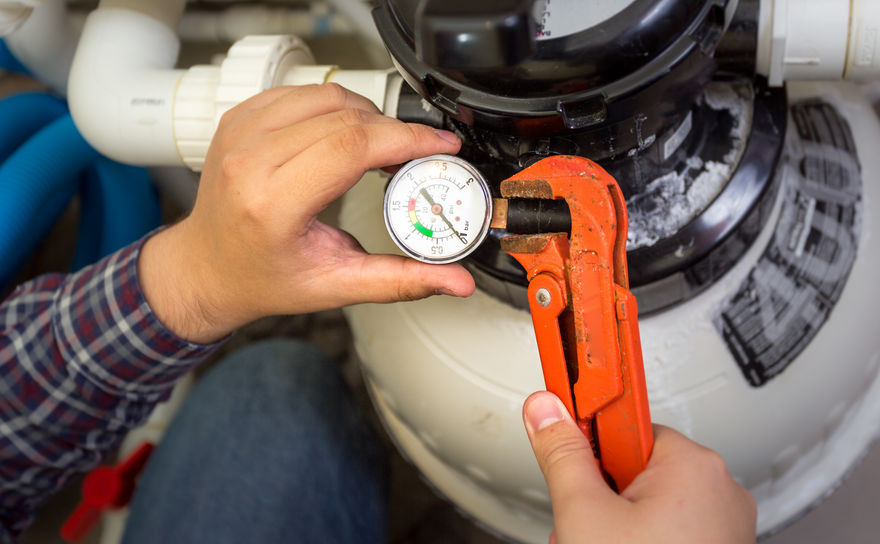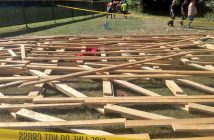A registered and licensed electrician was fatally injured while working on a water pump assembly

The pump was on a dairy farm in a very small pump shed.
The farm had pressure control issues with a water pump for approximately three days prior to the accident. The pump supplied water across the farm for stock drinking water.
The electrician initially replaced an old ‘loss of prime’ pressure switch with a temporary pressure control switch. He then returned to make permanent repairs, replacing the pressure switch with a single function pressure control switch – ‘loss of prime’ shut off.
During the testing phase of this process the pressure cylinder has been rapidly over-pressurised. This caused a catastrophic failure of the base of the steel pressure cylinder.
The bottom blew out of the cylinder propelling it out through the roof of the pump shed.
The pump shed was destroyed and the electrician was fatally injured by the pressure release explosion.
The water pump cylinder was in a very poor condition
The cylinder was over 20 years old. It was in a very poor condition showing severe pitting corrosion to the rear external side-wall of the cylinder and in the lower third of the internal surface.
The steel mounting skirt at the base of the cylinder was almost totally corroded. The absence of most of the mounting skirt meant the cylinder was virtually free floating on its pipework causing additional stress to the base of the cylinder.
No pressure relief valve had been fitted to the pumping system
The data plate on the pressure cylinder clearly identified it had a safe working pressure of 125psi. A new replacement pump had been installed approximately two years earlier, and was capable of pumping a pressure of 165psi.
No Pressure Relief Valve (PRV) was fitted to the pumping system to protect the aging cylinder from the ncreased pressure rating of the new pump.
The ‘Loss of Prime’ switch was not fit-forpurpose as it was installed.
A single function pressure control switch – ‘loss of prime’ shut off was installed without a pressure switch in series with it. This allowed the pump to over-pressurise the cylinder beyond its pressure capability.
The ‘Loss of Prime’ switch installed was assumed to control both lower and upper pressure limits of the pump; however, this was not the case.
What occured next?
The pump quickly over-pressured the cylinder beyond its pressure capability, which together with the condition of the cylinder resulted in the catastrophic failure of the pressure cylinder.
![[image]damaged pressure cylinder.](https://worksafe.govt.nz/assets/About-us/News-and-media/WKS-TB-Pump-2.jpg)
![[image]damaged pressure cylinder lying on its side.](https://worksafe.govt.nz/assets/About-us/News-and-media/WKS-TB-Pump-1.jpg)
A combination of, but not limited to, the following factors, may have contributed to the catastrophic failure of the pressure cylinder:
- the new pump having a greater working pressure than the rating of the pressure cylinder
- the age and advanced corrosion in the structure of the pressure cylinder which compromised its structural integrity
- the installation of an inappropriate type of pressure switch
- the absence of a pressure relief valve in this pumping system.
Worksafe’s recommendations
- We strongly recommend that associated service personnel completely check the entire water pump assembly to check the integrity of older parts and ensure that the introduction of new parts are appropriate for the existing set-up.
- All farm owners, farm workers and associated service personnel follow the manufacturers’ and suppliers’ operating instructions and guidance material relating to the installation, use and maintenance of farm and commercial use pressurised water pumping systems and associated equipment.
- Where a single function pressure control switch – ‘loss of prime’ shut off is chosen, this switch should be installed to control the low pressure start-up sequence of the pump only, with a high pressure cut-out switch installed ‘in-line’ to control the high pressure cut-out protection.
- Confirm that all pressure control components installed into any pressurised pumping systems are capable of and are calibrated to meet the manufacturer’s specified limitations of the various and collective parts of the pumping system.
- Consider the age and potential condition of pressure components when maintenance is being planned and/or carried out.
- Visually inspect older pressure cylinders for signs of surface deterioration with surface rust and/or severe pitting corrosion.
- Where components are replaced, refurbished or upgraded, confirm that the pressure safety limits of individual items are compatible and not compromised without the fitting of appropriate safety devices, i.e. Pressure Relief Valve (PRV).




